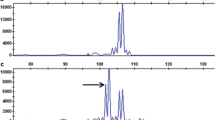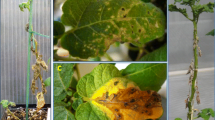Abstract
As part of the International Potato Center’s (CIP) virus resistance breeding strategy, a group of 182 selected clones from intercrosses among duplex Potato Virus Y (PVY) immune progenitors derived fromSolanum tuberosum ssp.andigena (i.e., YYyy × YYyy) was sampled. These clones were test-crossed to the PVY susceptible tester 377964.5 (yyyy) to search for triplex (YYYy) and quadruplex (YYYY) PVY immune potato progenitors. Seedlings of each test-crossed progeny were screened for PVY immunity. Genetic analysis of observed ratios for immunity-susceptibility showed that two of the 182 clones segregated as triplex under the assumption of a random chromatid segregation model. The double reduction coefficient, α, and its standard error were estimated from the experimental data, and had values of 0.1566 and 0.0186 respectively. These results indicated that crossovers take place during meiosis between the locus and the centromere, permitting sister chromatids to migrate to the same pole producing a random chromatid segregation. In the population evaluated, no clone was identified as a quadruplex. The two triplex PVY immune genotypes will produce about 96% of progenies with PVY immunity when mated to PVY susceptible advanced clones or varieties. These progenitors have the potential to provide a durable PVY genetic control and diminish the present impact of this virus on the potato crop. Also, immunity to PVY will significantly simplify the seed production process.
Compendio
El presente trabajo es una parte importante de la estrategia de mejoramiento para resistencia a virus conducida en el Centro Internacional de la Papa (CIP). Una muestra de 182 clones seleccionados, provenientes de cruzamientos entre progenitores dúplex inmunes al virus Y de la papa (PVY) derivados deSolanum tuberosum ssp.andigena (v.g., YYyy × YYyy), fueron cruzados al clon 377964.5 susceptible a PVY (yyyy). Estos cruzamientos se efectuaron con el objeto de identificar clones progenitores tríplex (YYYy) y cuádruplex (YYYY) inmunes a PVY. Se utilizó una muestra de plántulas de cada cruce para efectuar el tamizado por inmunidad a PVY. El análisis genético de las proporciones observadas de inmunidad-susceptibilidad mostró que dos de los 182 clones segregaron de acuerdo con las proporciones esperadas para un tríplex bajo un modelo de segregación cromatídica al azar. El coeficiente de doble reduccion, α, y su error estandar fueron estimados de los datos experimentales y sus magnitudes fueron de 0.1566 y 0.0186, respectivamente. Estos resultados indican que durante la meiosis se produce entrecruzamiento (crossing-over) entre el locus y el centrómero. Esto permite la migración conjunta de cromátidas hermanas al mismo polo, dando lugar a una segregación cromatídica al azar. En la población evaluada no se identificó ningún genotipo cuádruplex. Los dos genotipos tríplex identificados al ser apareados a clones avanzados o variedades, susceptibles a PVY, producirán progenies con una frecuencia de alrededor de 96% de individuos inmunes a PVY. Estos progenitores tienen el potencial de proporcionar un control duradero al PVYy de minimizar el impacto de este virus en el cultivo de la papa. Además, la inmunidad al PVY simplificará significativamente el proceso de producción de semilla.
Similar content being viewed by others
Literature Cited
Allard, R.W. 1966. Principles of Plant Breeding. Ed. J. Wiley and Sons, Inc., J. Wiley and Sons, Inc., New York. 485 pp.
Fernández-Northcote, E.N. 1989. Variability of PVX and PVY and its relationship to genetic resistance.In: Control of virus and virus like diseases of potato and sweet potato. CIP, Lima, Peru. pp. 131–139.
Fernández-Northcote, E.N. 1991. Potato seedling screening for resistance to potato viruses X and Y by the mass inoculation technique with spray gun. CIP Research Guide 37. International Potato Center, Lima, Peru. 12 pp.
Gálvez, R., H.A. Mendoza, and E.N. Fernández-Northcote. 1992. Herencia de la inmunidad al virus Y de la papa (PVY) en clones derivados deSolanum tuberosum ssp.andigena. Fitopatología 27(1):8–15.
Kempthorne, O. 1969. An Introduction to Genetic Statistics. Iowa State University Press, Arnes, IA, USA. 545 pp.
Mendoza, H.A., E.N. Fernández-Northcote, U. Jayasinghe, L.F. Salazar, R. Gálvez, and C. Chuquillanqui. 1989. Breeding for resistance to potato viruses Y, X, and leafroll: Research strategy, selection procedures, and experimental results.In: Control of virus and virus-like diseases of potato and sweet potato. International Potato Center, Lima, Peru. pp. 155–172.
Mendoza, H.A. 1993. Experiences, difficulties and prospects for durable resistance breeding in potatoes.In: Durability of disease resistance. Th. Jacobs and J.E. Parlevliet (eds.) Kluwer Academic Publishers. Netherlands. pp. 249–257.
Muñoz, F.J., R.L. Plaisted, and H.D. Thurston. 1975. Resistance to Potato Virus YinSolanum tuberosum ssp.andigena. Am Potato J 52:107–115.
Author information
Authors and Affiliations
Rights and permissions
About this article
Cite this article
Mendoza, H.A., Mihovilovich, E.J. & Saguma, F. Identification of triplex (YYYy) Potato Virus Y (PVY) immune progenitors derived fromSolanum tuberosum ssp.andigena . American Potato Journal 73, 13–19 (1996). https://doi.org/10.1007/BF02849300
Accepted:
Issue Date:
DOI: https://doi.org/10.1007/BF02849300




